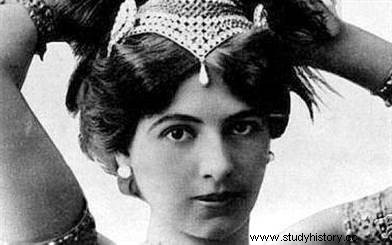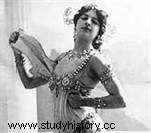 Dutch Mata Hari is a specialist in oriental dances, whose shows met with great success in Paris at the beginning of the 20th century. When the First World War broke out, his status as an artist allowed him to travel throughout Europe. Returning from a trip to Germany, Mata Hari is arrested by the French government who accuses her of espionage. She was sentenced to death and shot at Vincennes on October 15, 1917. Behind the myth that stems from the exoticism of her dancer's tinsel and the mystery of her activity as a spy, however, hides a simple seducer. For the majority of historians, she would have been only an amateur, and her action negligible.
Dutch Mata Hari is a specialist in oriental dances, whose shows met with great success in Paris at the beginning of the 20th century. When the First World War broke out, his status as an artist allowed him to travel throughout Europe. Returning from a trip to Germany, Mata Hari is arrested by the French government who accuses her of espionage. She was sentenced to death and shot at Vincennes on October 15, 1917. Behind the myth that stems from the exoticism of her dancer's tinsel and the mystery of her activity as a spy, however, hides a simple seducer. For the majority of historians, she would have been only an amateur, and her action negligible.
Mata Hari, exotic dancer
Born in August 1876 in Holland, Mata Hari, whose real name is Margaretha Geertruida Zelle, had to face the bankruptcy of her father during her youth. Offering her heart to a young Dutch officer, she leaves for the island of Java, which is then a Dutch colony. It was here that she took the name of Mata Hari, meaning in the local language, the "sun", or more metaphorically "the eye of the day", and was introduced to oriental dance. Weary quickly of Javanese life and traumatized by the death of her son, she decides to return to the Old Continent, where she separates from her husband.
 A new adventure awaits her in Paris, where she quickly discovers a talent for dancing, and creates adds a character by inventing Hindu origins. From 1905, she had a certain success, and, using her devastating charm, accumulated male conquests. However, little by little, the public turned away from his shows, preferring the Russian ballets which spread in the French capital.
A new adventure awaits her in Paris, where she quickly discovers a talent for dancing, and creates adds a character by inventing Hindu origins. From 1905, she had a certain success, and, using her devastating charm, accumulated male conquests. However, little by little, the public turned away from his shows, preferring the Russian ballets which spread in the French capital.
Agent H21:a spy in the service of Germany
August 1914:war breaks out. Mata Hari is then in Berlin, in a very delicate financial situation. She returns to the Netherlands, a country not involved in the conflict. A German intelligence officer comes to meet her, offering her to become, after a little training, a spy on behalf of Germany. Destitute, she can only accept this mission which offers her the possibility of infiltrating the political and military world.
Mata Hari, whose code name is agent H21, was first, in 1916, sent to Paris, where she multiplied the conquests - especially among the officers whose she says she is fascinated - and even falls in love with a young Russian officer, Vadim Masloff. His wanderings alongside this young Vadim Masloff led him to meet Captain Ladoux, chief of the 5 ème office of the General Staff, in other words of counterintelligence, which had already spotted her espionage activities and wishes to make her a double agent:Mata Hari accepts.
"Who kisses too badly hugs"
 Mata Hari's mission is to operate in neutral countries:she therefore leaves for Holland and Spain, two theaters struggle between the German intelligence services and the French secret services. In Madrid, she manages to meet and quickly seduce the German military attaché, Major Kalle. After the departure of the spy, Major Kalle sends a telegram to Berlin, very explicitly mentioning the information provided by agent H21. This telegram is, like many others during the conflict, intercepted by the French from the Eiffel Tower. Was Major Kalle reckless in mentioning Mata Hari so clearly or did he want to get rid of Agent H21, feeling that she was playing a double game?
Mata Hari's mission is to operate in neutral countries:she therefore leaves for Holland and Spain, two theaters struggle between the German intelligence services and the French secret services. In Madrid, she manages to meet and quickly seduce the German military attaché, Major Kalle. After the departure of the spy, Major Kalle sends a telegram to Berlin, very explicitly mentioning the information provided by agent H21. This telegram is, like many others during the conflict, intercepted by the French from the Eiffel Tower. Was Major Kalle reckless in mentioning Mata Hari so clearly or did he want to get rid of Agent H21, feeling that she was playing a double game?
On returning to France, Mata Hari is followed very closely by the French counterintelligence services, who do not want to be fooled by the Dutch spy. On February 13, 1917, she was finally arrested. An investigation is entrusted to Captain Bouchardon, who collects the evidence - including evidence of money paid by Germany - and conducts the interrogations. This time, Mata Hari fails to seduce the officer:on the contrary, she appears helpless and can only confess. For the money, Mata Hari wanted to fool two intelligence services. She was never a real spy, not providing any real information to the services that employed her.
Execution and posterity of Mata Hari
 On October 15, 1917, she was finally sentenced to death and executed by firing squad at the fortress of Vincennes. The context of the mutinies in 1917 undoubtedly weighed in the choice of its execution:it was necessary to make an example of the firmness of France in its infallible will to overcome the enemy. The myth was formed, making Mata Hari, an attractive woman who had no influence in the Franco-German secret war, a great and vile spy in the service of Germany. The arrest of Mata Hari unleashed a veritable wave of "spying" of which ministers Caillaux and Malvy were the most famous victims.
On October 15, 1917, she was finally sentenced to death and executed by firing squad at the fortress of Vincennes. The context of the mutinies in 1917 undoubtedly weighed in the choice of its execution:it was necessary to make an example of the firmness of France in its infallible will to overcome the enemy. The myth was formed, making Mata Hari, an attractive woman who had no influence in the Franco-German secret war, a great and vile spy in the service of Germany. The arrest of Mata Hari unleashed a veritable wave of "spying" of which ministers Caillaux and Malvy were the most famous victims.
Several film adaptations, biographies and video games have been made based on the life of Mata Hari, helping to anchor this spy's name in people's minds. A regular heroine on the big and small screens, she was notably played by Greta Garbo (Mata Hari by George Fitzmaurice, 1932) and Jeanne Moreau (Mata Hari, agent H 21 by Jean-Louis Richard, 1964).
Bibliography
- Mata-Hari, the secret file of the Council of War, by Jean-Pierre Turbergue. Italic Editions, 2001.
- Mata-Hari:its true story, by Philippe Collas. Plon, 2003.
- Mata Hari:Dreams and Lies, by Fred Kupferman. Cartridge, 2011.
